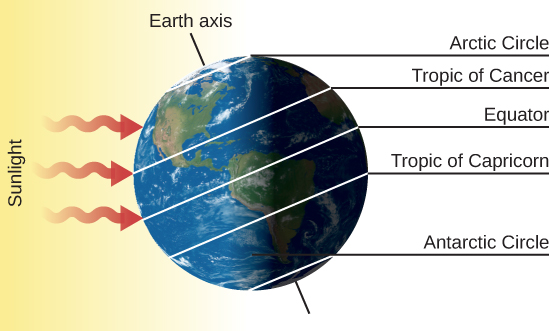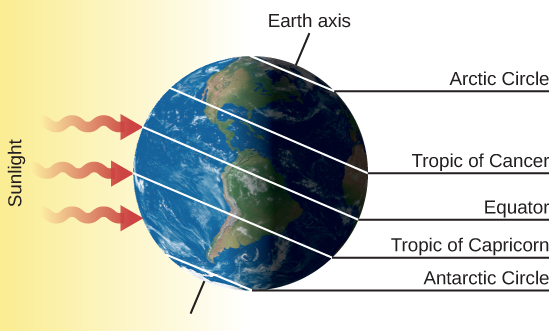| << Chapter < Page | Chapter >> Page > |

Many early cultures scheduled special events around the summer solstice to celebrate the longest days and thank their gods for making the weather warm. This required people to keep track of the lengths of the days and the northward trek of the Sun in order to know the right day for the “party.” (You can do the same thing by watching for several weeks, from the same observation point, where the Sun rises or sets relative to a fixed landmark. In spring, the Sun will rise farther and farther north of east, and set farther and farther north of west, reaching the maximum around the summer solstice.)
Now look at the South Pole in [link] . On June 21, all places within 23° of the South Pole—that is, south of what we call the Antarctic Circle —do not see the Sun at all for 24 hours.
The situation is reversed 6 months later, about December 21 (the date of the winter solstice , or the first day of winter in the Northern Hemisphere), as shown in [link] . Now it is the Arctic Circle that has the 24-hour night and the Antarctic Circle that has the midnight Sun. At latitude 23° S, called the Tropic of Capricorn , the Sun passes through the zenith at noon. Days are longer in the Southern Hemisphere and shorter in the north. In the United States and Southern Europe, there may be only 9 or 10 hours of sunshine during the day. It is winter in the Northern Hemisphere and summer in the Southern Hemisphere.

The Arctic Circle marks the southernmost latitude for which the day length is 24 hours on the day of the summer solstice. This is located at 90° – 23° = 67° N of Earth’s equator. If Earth were tilted a bit less, then the Arctic Circle would move farther North. In the limit at which Earth is not tilted at all (its axis is perpendicular to the ecliptic), the Tropic of Cancer would be right on Earth’s equator, and the Arctic Circle would simply be the North Pole. Suppose the tilt of Earth’s axis were tilted only 5°. What would be the effect on the seasons and the locations of the Tropic of Cancer and Arctic Circle?

Notification Switch
Would you like to follow the 'Astronomy' conversation and receive update notifications?